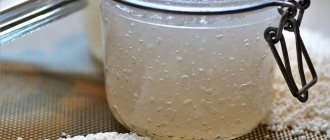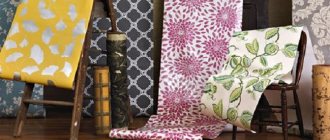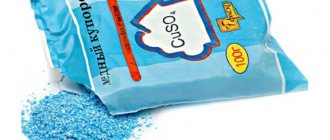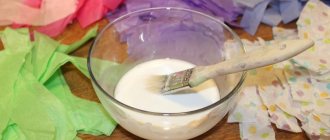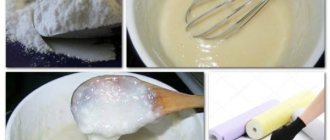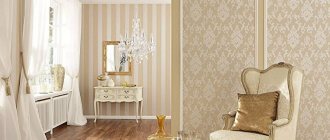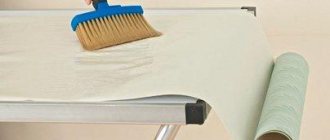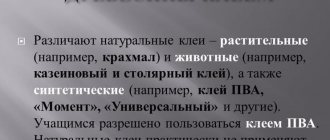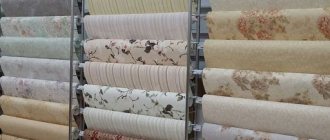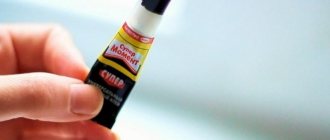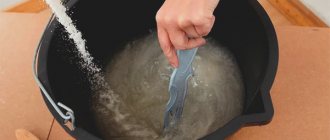There is absolutely nothing wrong with the fact that the wallpaper suddenly peels off, and there is absolutely no wallpaper glue in the house. For a small area, it is unlikely that anyone will run to the store and buy expensive glue to use it once. You can make glue with your own hands, which will be no worse than imported glue from the store. It can even be said that in villages people still use homemade adhesives and their wallpaper sticks even on damp walls without any preparation for gluing.
What is paste
A translucent mass resembling thick jelly and possessing the properties of glue is called paste. It is cooked from products containing amylopectin. Starch contains the maximum content of this substance. When it gets into hot water, its molecules increase in size, so the solution becomes viscous and dense. The result is a paste that has a translucent structure that is slippery to the touch and sticks your fingers together.
Starch paste ensures good adhesion of wallpaper to walls or ceilings. Its quality, subject to the cooking technology, is in no way inferior to ready-made brands of glue available for sale.
Paste is prepared from all types of starch and flour. The compositions have distinctive abilities:
| Types of starch and flour | Paste properties |
| Corn | Durable hardening. Increased shelf life. |
| Potato | Has a transparent structure. Sets slowly. It sours quickly in the heat. |
| Wheat flour | Hardening is average. Does not spoil for 2-4 days. Does not have transparency. |
| Rye flour | It has increased strength with the addition of turpentine. The composition dried on surfaces is resistant to moisture. |
Rules for wallpapering
Among the main reasons why wallpaper peels off is an irresponsible approach to the process itself. Undoubtedly, wallpapering walls is not very difficult, but still this work requires knowledge of some nuances:
- When purchasing a product, pay special attention to its quality. Opt for trusted manufacturers - on the advice of friends or in products that you are confident in.
- Before starting work, carefully read the instructions from the manufacturer.
- To work with wallpaper, purchase special tools that can facilitate the process and reduce the time of pasting walls.
- Finishing with wallpaper requires careful preparation of the walls - puttying, priming and other types of work.
Preparing walls before wallpapering
- Wall finishing should be carried out before the heating season, because drying is carried out under natural conditions.
- Eliminate drafts. A couple of days without open windows will help improve the quality of wallpaper adhesion to the wall surface.
How to cook paste
There are several recipes for cooking glue. Starch is used in its pure form or combined with other components. Preparation is simple and does not require material costs. For cooking you will need:
- metal container: enameled or stainless steel;
- a sieve or piece of gauze for straining;
- whisk or spatula.
Classic potato starch recipe
Classic paste consists only of starch and water. Boil it in a metal container of sufficient volume.
You can weld it as follows:
Sift the starch to remove any lumps or possible impurities. Dilute with water in a 1:1 ratio. Gradually add the powder to the liquid, stirring continuously. The approximate proportions of starch are 5 tablespoons per 1 liter of water. If the paste is intended to be used for priming walls, reduce the amount of dry matter by 20-30%. For gluing heavy wallpaper, increase by 1-2 spoons per liter. With continuous stirring, pour the resulting mixture in a thin stream into water preheated to 80-90 degrees. Continue stirring the solution and heat it over low heat until it thickens. Approximately 5-7 minutes. Strain the paste through a sieve or cheesecloth to remove lumps. This must be done before the composition has cooled down. Then it will thicken and it will be difficult to strain.
The paste can be used only after it has cooled completely. You need to prepare a portion for full use during the day.
Starch and flour
The paste according to this recipe is of high quality and strong. It is prepared like this:
- Mix 100 g of flour and 100 g of starch and dilute in 200 ml of cool water. Bring 800 ml of water to 80-90 degrees.
- Pour the starch-flour solution into boiling water in a thin layer with continuous stirring.
- Heat over low heat, avoiding boiling.
To evaluate the quality of the welded glue, wet your fingers with it and connect them for 1-2 minutes. Then try separating them. The more difficult you manage to do this, the stronger the glue is.
High-hold adhesive
To glue heavy paper, vinyl and non-woven wallpaper, ready-made PVA glue is added to a solution of starch and water. Preparation proportions:
- starch - 2-3 tbsp. l.;
- water - 1 l;
- PVA glue - 2-3 tbsp. l.
Prepare glue like this:
- Pour starch into 0.5 liters of cool water and stir.
- Add 500 ml of boiling water into the container while stirring vigorously.
- Bring the solution to a boil, stirring constantly.
- After cooling, pour in PVA and mix vigorously again.
If you plan to stick dark wallpaper, you can add wood glue instead of PVA. The resulting composition is capable of providing high-quality fixation of the heaviest wallpaper. The proportions of the component are 20 g per 1 liter of finished paste.
To obtain a waterproof composition, add calcium chloride:
- Dissolve 40 g of calcium in 600 ml of water. Separately, dilute 400 g of starch in 400 ml of water.
- Combine the two solutions and pour into 4 liters of hot water.
- Heat for 4 minutes. Strain after 2-3 hours.
If starch is heated for 2 hours at 160 degrees in the oven, it is converted into a special substance - dextrin. The resulting brownish lumps are ground into powder and diluted with boiling water (1:3). Add 30 g of sugar per 100 g of powder. The glue dries instantly and holds the wallpaper tightly.
Additional options
There are several types of glue that are not as popular for home preparation as those described above, but no less effective.
Glue stick
The glue is based on PVA. In order to make an analogue of a store-bought “pencil”, you will need a bottle of solid deodorant. It is important that the lid closes tightly. Otherwise the glue will dry out.
To prepare you will need:
- laundry soap (2 parts);
- clean water (1 part);
- PVA (4 spoons).
Soap is mixed with water and melted for steam. After dissolving the soap shavings, PVA is added to the solution.
After mixing thoroughly, allow the mixture to cool. After this, the glue is poured into the deodorant packaging. After some time it will harden to a solid state.
There is also a reverse way to “transform” a glue stick into PVA.
Super glue
The full composition of the usual super glue is not available to the common man. However, it is possible to make a strong adhesive composition for various surfaces at home.
For this you will need:
- wood glue - 125 g;
- granulated sugar - 100g;
- slaked lime - 35 g;
- clean water - 450 ml.
A mixture of water and lime is heated by steam, after which wood glue is poured into the solution and sugar is added. When all the ingredients become a homogeneous mass, the glue is ready for use. This composition is suitable for metal, porcelain and ceramic products.
Foam glue
It is difficult to find reliable adhesive for foam blanks. This is due to the structure and characteristics of the material. Wood glue is mainly suitable for working with foam plastic.
Another popular method is the use of casein glue. However, for best results, it should be mixed with slaked lime in equal proportions.
How to use starch glue
The paste is used in everyday life for the following purposes:
- Wallpapering and priming walls. The surface treated with the composition becomes smooth and ensures good adhesion to materials.
- Preparing small seeds for sowing. They are glued to toilet paper, then the prepared tapes are placed in the soil. To protect the seeds from insects, add a little salt to the composition.
- Handicrafts and children's creativity. The paste is used in the manufacture of appliqués, papier-mâché and fabric products, and scrapbooking. This safe composition is especially welcome in organizing children's creativity: the paste is completely safe, even if a child swallows it.
When gluing wallpaper, the paste is spread in a thin layer on the back side. Then leave for a few minutes for the composition to be absorbed. Immediately after application, the canvas cannot be glued to the wall.
All doors and windows in the room must be closed during operation. A draft will cause the glue to dry unevenly and the wallpaper will fall off.
Starch is a food product, so the paste is susceptible to attack by bugs and the development of mold under the wallpaper. To impart antiseptic properties to the composition, copper sulfate is mixed into the starch (1 g per 100 g of starch).
Main components of the compositions
The composition of the adhesive is the most important factor determining its adhesive properties. Now on packaging with mixtures you can see shocking compositions, replete with a variety of components.
However, in Soviet times, the glue was based on simple and accessible substances, and one could only envy the strength and reliability of the finished composition. The glue of yesteryear was made to last for centuries, as evidenced by many things from that era that have survived to this day.
Previously, flour or starch was used as a base. These products are excellent binders. However, to impart special properties to the mixture, additional components are required:
- Ceramic slabs require cement;
- rubber glue uses dissolved rubber;
- Gelatin must be present in stationery compositions.
Sometimes, to give special strength to homemade glue, ready-made dry mixtures are added to the main components.
Depending on the purpose, there are different options for how to make glue.
Advantages and disadvantages of this glue
The main advantages of the paste are its low price and absolute safety. Starch is a cheap, natural product. It does not contain harmful substances and does not cause allergies. Add the benefits of the composition:
- the ability to reliably glue paper-based materials;
- absence of unpleasant odor and marks on the surface when gluing;
- ease of preparation;
- ease of dismantling wallpaper for repeated repairs.
Disadvantages of paste:
- instability to moisture;
- the preparation process, compared to store-bought formulations;
- short shelf life.
Ways to Improve Your Purchased Wallpaper Mix
Purchased products do not always meet expectations, and in some cases they need to improve the quality of the original composition. The reason could be anything: low-quality products or banal savings on purchasing higher-quality material. In this case, you can use the following tips:
- To get started, read the instructions left by the manufacturer on the back of the wallpaper paste package. You don’t have to rely entirely on your memory and think that you know exactly how to cook correctly. In some cases, the manufacturer adds new components that can significantly affect the method of preparing the adhesive solution.
- After preparing according to the instructions, add regular sugar to the glue. The ratio of the mixture to the bulk component should be within 1:10. This combination improves the quality of adhesion of the original composition.
There are other methods of strengthening the adhesive composition. For example, add PVA glue, which will enhance the moisture-repellent qualities of the composition.
Cooking errors
The quality of the paste depends on compliance with the technology of its preparation. But often beginners make mistakes when cooking and get negative results. The following mistakes prevent you from making a high-quality paste:
- Add dry starch directly to boiling water. The gluten sets instantly, and the mass turns out with lumps.
- Neglecting stirring. To evenly distribute the dry matter, the paste must be stirred intensively and continuously when heated. If you linger for a minute, the mass will turn into a lump.
- Adding dry powder to water. This provokes the formation of lumps. You need to do the opposite: pour water into the starch.
How to restore thickened glue
The paste, placed in a cold place, can be stored for up to 5 days. However, it may become too thick. This will make it difficult to apply the composition to the wallpaper, increase consumption, and reduce the quality of gluing the material. But do not rush to throw away the thickened paste. Adding a small amount of hot water will help revive it.
The procedure is as follows:
- Bring the water to a boil.
- Remove the crust that has formed from the surface of the paste. If this is not done, it will turn into lumps.
- Then, with constant stirring, pour boiling water into the paste. Add water gradually, controlling the consistency of the paste.
- Cool the cooked mixture slightly and strain it to remove any lumps formed during thickening.
If mold has formed in the thickened paste after storage, it should be thrown away. Restoring such a composition will not prevent the growth of fungus, and pathogenic microorganisms will multiply under the pasted wallpaper.
Paste is a cheap, healthy and at the same time very effective adhesive composition. If the preparation technology is followed, it firmly fixes paper, non-woven and vinyl wallpaper on most surfaces. For paper-based finishing materials, this is an ideal product.
The composition is safe and does not cause negative reactions in the body. They can be used for wallpapering in the rooms of allergy sufferers and small children. The pasted material, if necessary, can be easily removed from the surfaces after a little moistening.
Some advice from experts
For gluing wallpaper and pasting paper on walls, it is quite possible to use homemade glue. However, in this case, it is better to choose canvases in pastel and similar colors. This is explained by the fact that after a short period of use, yellow spots appear on the surface.
If you are afraid to experiment with expensive non-woven wallpaper, then purchase ready-made adhesive mixtures in advance. The high price of products makes you think about this point in advance.
The most suitable place for pasting walls is a country house, where the responsibility is minimal. However, in this case, it is recommended to use insecticide additives in the form of fungicides or other additives.
